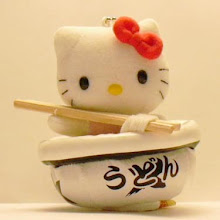Noodles and Stuff: Nabemono
 Clearly the ramen post kicked off a noodle phase in my eating habits. After having a bit of nabeyaki udon (chinese cabbage, shiitake mushrooms, fishcake, poached egg and green onion simmered altogether in a pot) for dinner last night, I awoke still craving noodles. I realized that with Spring finally here, the season of noodles and dishes like nabeyaki have come to an end. Always behind the seasons, I felt inspired to write about those wonderful nabemono dishes that fix a blue mood on a cold rainy day.
Clearly the ramen post kicked off a noodle phase in my eating habits. After having a bit of nabeyaki udon (chinese cabbage, shiitake mushrooms, fishcake, poached egg and green onion simmered altogether in a pot) for dinner last night, I awoke still craving noodles. I realized that with Spring finally here, the season of noodles and dishes like nabeyaki have come to an end. Always behind the seasons, I felt inspired to write about those wonderful nabemono dishes that fix a blue mood on a cold rainy day.
Nabe is a cooking pot (clay or cast iron) and mono refers to all the ingredients that will be used for making a complete meal. Vegetables, meat and noodles are simmered together and served "family-style."
One famous example of nabemono is Sukiyaki, which is thinly sliced beef that is stewed in a sweet soy broth with tofu, shiitake and mung bean noodle. My mom's winter favorite is Oden which is a big production involving two different kinds of fish cake, fried tofu, cabbage, konnyaku, potato, radish, eggs and finally "treasure pouches" which are fried tofu skins filled with meat. A lot of work goes into making dishes like Oden, so much so that these days it's not uncommon to find frozen Oden kits that are ready to go. Ever anxious to keep up with the Kitty market, Asunaro also makes a Hello Kitty version of Oden that comes in a can...
Back in the Genyo era there was a limited seasonal kitty dedicated to nabemono called "Nabebugyo." The series featured 10 regional examples of nabemono. During my collecting days, I was only able to find one mascot from this particular series, but Kitty has a way of cross referencing herself in the regionals so I hoped for some luck.

This kitty version features a specialty of Hokkaido, Ishikari-nabe: Salmon stewed in a miso broth with potato, konnyaku, cabbage, chrysanthemum greens, radish, tofu, green onion and butter!

Ah! Close up of those hot pot ingredients...
As I had hoped earlier on, I did get lucky in the regional varieties. The next Kitty is one of my all time favorite original mascots: Houtou Kitty from Yamanshi Prefecture. In this dish the udon is an extra wide noodle that is a specialty of the region. The mono include Yamanashi specialties like mushrooms and Kabocha - that beautiful pumpkin-like squash. Everything is stewed together in a hearty miso broth.

No family-style service from this nabe. Kitty is IN the pot getting a heaping serving of that thick udon. I guess she loves the Houtou more than the usual nabemono. I wonder how Daisy feels about eating furry stew...
If you're interested in making nabemono, there's a number of fun/quirky videos on youtube that show you how to make a few of them like Oden.
Cooking with Dog: I am a new fan of these quirky but informative videos on Japanese cooking











